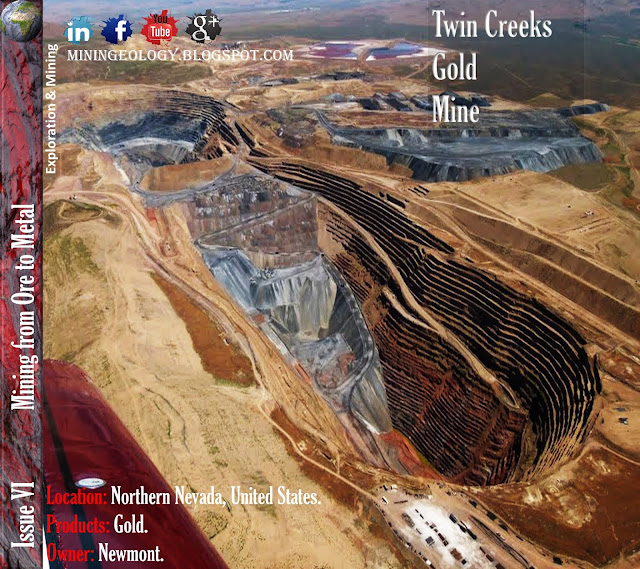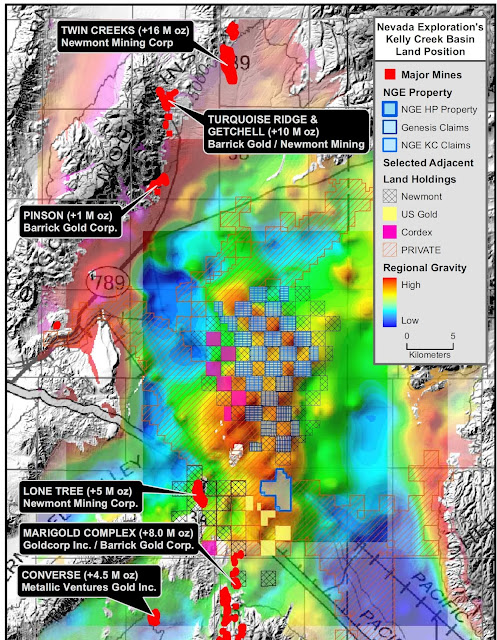Twin Creeks Mine
Location: Northern Nevada, United States.
Products: Gold.
Owner: Newmont.
Deposit size: Length 4 km
Width 1 km
Area 3 sq km
Deposit features: Beds or lenses
Dikes or sills
Fault zone
Deposit age geologic: Eocene
Intrusive rock: Dacite porphyry
Ore bearing unit: Pennsylvanian–Permian Etchart Fm.; Ordovician Valmy Fm. and Comus Fm.
Ore bearing unit thickness: 3000 m
Tectonic setting: North-American craton rifted western margin, imbricate structure.
Alteration : Contact metamorphism (?) decarbonatization, oxidation & silicification (jasperoid)
Associated deposits: sediment-hosted Au
Discovery date: 1984
Operation types: Open pit, Crushing and milling & Heap leach.
Total tonnage: 223.4tonnes
Contained gold: 484 tonnes
Recovery: Au 80%
Gold grade: 2.67 g/t
Reserves (December 31, 2014): 0.158M oz. gold
BY -Dr.R.N.Mishra-
Nevada is one of the most important metal-mining States of the West and has produced large quantities of gold, silver, and lead. At present her production of precious metals is again rising rapidly, and although the output of lead is much smaller than formerly the State is now an important producer of copper. The mining districts number about 200.
The northern boundary line of Nevada lies within the province of the Columbia River lava, and these flows of basalt and rhyolite extend for some distance into the State. At the bend of the California State line the Sierra Nevada forms the boundary of Nevada and a small part of that great range is included within its limits.
TWIN CREEKS MINE has Sediment-hosted gold deposit in Nevada, U.S.A. The USGS recognised the deposit as Carlin Subtype, manifested as Beds or lenses, Dikes or sills or of Fault zone kind of mineralisation. The Twin Creek Deposit has been surveyed and the dimensions are 4 km long x 1 km wide with an area of 3 sq.km. Generally, The Carlin–type deposits represent some of the largest hydrothermal gold deposits in the world.
The Carlin type deposits show enrichment in the elements gold, antimony, mercury, thallium and barium. This enrichment is created by hydrothermal circulation with a temperature of up to 300 °C. The underlying rocks out of which the minerals are dissolved are normally silty carbonates, although also silicates and other sediments are possible. The material in the deposit is altered in a way that the carbonate minerals are either dissolved or converted to the silicates by silicate rich hydrothermal water. For example dolomite is transformed into jasperoid. Another alteration is the formation of clay minerals by interaction of water and feldspar.
-Dr.R.N.Mishra-
Reference information
Bloomstein, E.I., Massingil, G.L., Parratt, R.L., and Peltonen, D.R., 1991, Discovery, geology, and mineralization of the Rabbit Creek gold deposit, Humboldt County, Nevada, in Raines, G.L., Lisle, R.E., Schafer, R.W., and Wilkinson, W.H., eds., Geology and ore deposits of the Great Basin, Symposium Proceedings: Reno, Geological Society of Nevada, p. 821–843.
Breit, F.J., Jr., Ressel, M.W., Anderson, S.D., and Muirhead, E.M.M., 2005, Geology and gold deposits of the Twin Creeks mine, Humboldt County, Nevada, in Rhoden, H.N., Steininger, R.C., and Vikre, P.G., eds., Symposium 2005—Window to the world: Reno, Nevada Geological Society, p. 431–451.
Briggs, D.F., 2006, Mining operations report, version 2005: Unpublished.
Groff, J.A., Heizler, M.T., McIntosh, W.C., and Norman, D.I., 1997, 40Ar/39Ar dating and mineral paragenesis for Carlin-type gold deposits along the Getchell Trend, Nevada—Evidence for Cretaceous and Tertiary gold mineralization: Economic Geology, v. 92, p. 601–622.
Hall, C.M., Kesler, S.E., Simon, G., and Fortuna J., 2000, Overlapping Cretaceous and Eocene alteration, Twin Creeks Carlin-type deposit, Nevada: Economic Geology, v. 95, p. 1739–1752.
Nevada Bureau of Mines and Geology, 2011, The Nevada mineral industry, 2010: Nevada Bureau of Mines and Geology Special Publication MI-2010, 151 p.
Newmont, 2012, Reserves and non-reserve mineralization: Annual Report of December 31, 2011, 8 p., last accessed May 8, 2012, at http://www.newmont.com/sites/default/files/u87/NEM_2011%20Attributable%20Reserves%20and%20NRM.PDF.
Osteberg, M.W., and Guilbert, J.M., 1991, Geology, wall-rock alteration, and new exploration techniques at the Chimney Creek sediment-hosted gold deposit, Humboldt County, Nevada, in Raines, G.L., Lisle, R.E., Schafer, R.W., and Wilkinson, W.H., eds., Geology and ore deposits of the Great Basin, Symposium Proceedings: Reno, Geological Society of Nevada, p. 805–819.
Simon, G., Kesler, S.E., and Chryssoulis, S., 1999, Geochemistry and textures of gold-bearing arsenian pyrite, Twin Creeks, Nevada—Implications for deposition of gold in Carlin-type deposits: Economic Geology, v. 94, p. 405–422.
Stenger, D.P., Kesler, S.E., Peltonen, D.R., and Tapper, C.J., 1998, Deposition of gold in Carlin-type deposits—The role of sulfidation and decarbonation at Twin Creeks, Nevada: Economic Geology, v. 93, p. 201–215.
Thoreson, R.F., Jones, M.E., Breit, F.J., Doyle-Kunkel, M.A., and Clarke, L.J., 2000, The geology and gold mineralization of the Twin Creeks gold deposits, Humboldt county, Nevada, in Crafford, A.E.J., ed., Geology and ore deposits—The Great Basin and beyond; Geology and ore deposits of the Getchell region, Humboldt County, Nevada: Geological Society of Nevada Symposium 2000, Field Trip 9, p. 85–111.










0 komentar:
Post a Comment